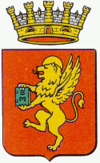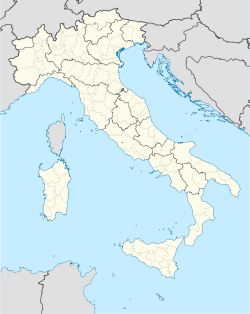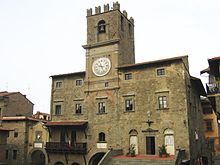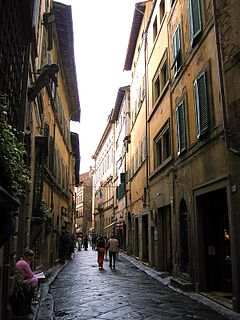- Cortona
-
Cortona — Comune — Città di Cortona 
Coat of armsLocation of Cortona in Italy Coordinates: 43°16′32″N 11°59′17″E / 43.27556°N 11.98806°ECoordinates: 43°16′32″N 11°59′17″E / 43.27556°N 11.98806°E Country Italy Region Tuscany Province Arezzo (AR) Frazioni Adatti, Bocena, Borgonuovo, Camucia, Cantalena, Capezzine Centoia, Casale, Cegliolo, Chianacce, Cignano, Creti, Falzano, Farneta, Fasciano, Fossa del Lupo, Fratta, Fratticciola, Gabbiano, Mengaccini, Mercatale, Mezzavia, Monsigliolo, Montalla, Montanare, Montecchio, Novelle, Ossaia, Pergo, Pierle, Pietraia, Poggioni, Portole, Riccio, Ronzano, Ruffignano, San Donnino Val di Pierle, San Lorenzo Rinfrena, San Marco in Villa, San Pietro a Cegliolo, San Pietro a Dame, Santa Caterina, Sant’Andrea di Sorbello, Sant’Angelo, Seano, Sodo, Tavarnelle, Terontola, Teverina, Tornia, Torreone, Valecchie, Vallone. Government – Mayor Andrea Vignini Area – Total 342.33 km2 (132.2 sq mi) Elevation 494 m (1,621 ft) Population (31 March 2009) – Total 23,041 – Density 67.3/km2 (174.3/sq mi) Demonym Cortonesi Time zone CET (UTC+1) – Summer (DST) CEST (UTC+2) Postal code 52044 Dialing code 0575 Patron saint Saint Margaret of Cortona Saint day 22 February Website Official website Cortona is a town and comune in the province of Arezzo, in Tuscany, Italy. It is the main cultural and artistic center of the Val di Chiana after Arezzo.
Contents
History
Originally an Umbrian city, it was conquered and enlarged by the Etruscans, who called it Curtun. Cortona eventually became a Roman colony under the name Corito. During the barbarian invasions of the 553, Cortona was sacked and destroyed by the Goths. Cortona became a Ghibellinian city state in the 13th century, with its own currency. From 1325 to 1409 the Ranieri-Casali family successfully ruled the town. After being conquered by Ladislaus of Naples in 1409, Cortona was sold to the Medici in 1411. In 1737, the senior branch of the Medici line went extinct and Cortona came under the authority of the House of Lorraine. Following the Italian Wars of Independence, Tuscany - Cortona included - became part of the Kingdom of Italy.
Cortona foundation legend
The foundation of Cortona remains mixed in legends dating to classical times. These were later reworked especially in the late Renaissance period under Cosimo I de' Medici. The 17th-century Guide of Giacomo Lauro, reworked from writings of Annio da Viterbo, states that 108 years after the Great Flood, Noah entered the Valdichiana via the Tiber and Paglia rivers. He preferred this place better than anywhere else in Italy, because it was so fertile, and dwelt there for thirty years. One of Noah's descendants was Crano his son who came to the hilltop and, liking the high position, the fine countryside and the calm air, built the city of Cortona on it in 273 years after the Great Flood.
Main sights
The prevailing character of Cortona’s architecture is medieval with steep narrow streets situated on a hillside (altitude 600 metres), embracing a view of the whole of the Valdichiana. From the Piazza Garibaldi (still referred to by the local population by its older name, Piazza Carbonaia) is a fine prospect of Lake Trasimeno, scene of Hannibal's ambush of the Roman army in 217 BC (Battle of Lake Trasimene). Parts of the Etruscan city wall can still be seen today as the basis of the present wall. The main street, via Nazionale, is the only street in the town with no gradient, and is still usually referred to by locals by its older name of Ruga Piana.
Inside the Palazzo Casali is the Museo dell'Accademia Etrusca, displaying items from Etruscan, Roman, and Egyptian civilizations, as well as art and artefacts from the Medieval and Renaissance eras. The distinguished Etruscan Academy Museum had its foundation in 1727 with the collections and library of Onofrio Baldelli. Among its most famous ancient artefacts is the bronze lampadario or Etruscan hanging lamp, found at Fratta near Cortona in 1840 and then acquired by the Academy for the large sum of 1600 Florentine scudi. Its iconography includes (under the 18 burners) alternating figures of Silenus playing panpipes or double flutes, and of sirens or harpies. Within zones representing waves, dolphins and fiercer sea-creatures is a gorgon-like face with protruding tongue. Between each burner is a modelled horned head of Achelous. It is supposed that the lampadario derived from some important north Etruscan religious shrine of around the second half of the fourth century BC. A later (2nd century BC) inscription shows it was rededicated for votive purposes (tinscvil) by the Musni family at that time.[1] The Museum contains several other important Etruscan bronzes.
 The Fra Angelico Annunciation.
The Fra Angelico Annunciation.
Etruscan chamber-tombs nearby include the Tanella di Pitagora (halfway up the hill from Camucia), two at the foot of the hillside at Il Sodo, and a complex in Camucia itself. Il Sodo I contains pitch-roofed chambers of slab construction with an inscription, and can be visited. Il Sodo II contained a large stone-stepped altar platform with carved sphinxes devouring warriors.[2]
The town's chief artistic treasures are two panels by Fra Angelico in the Diocesan Museum, an Annunciation and a Madonna and Child with Saints. A third surviving work by the same artist is the fresco above the entrance to the church of San Domenico, likewise painted during his stay at Cortona in 1436. The Diocesan Museum houses also a group of work by Giuseppe Maria Crespi, known as Lo Spagnuolo, called Ecstasy of St. Margaret. The Academy Museum includes the very well known painting Maternità of 1916 by the Cortonese artist Gino Severini. There are also examples of the works of Pietro da Cortona.
Renaissance architecture
Two of the churches in Cortona are prime examples of two different principles of Renaissance construction.
Santa Maria Nuova, built by Giorgio Vasari in 1554, is a church of square ground-plan. It is on a Greek cross plan and is surmounted by a main cupola which was only finished during the 17th century, a primary example of such a centralised design. Inside are four large columns which supports the lantern of the cupola. At the sides the four arms of the cross branch out covered with barrel-vaults, while four small cupolas arise in the spaces of the angles. Among the works of art are the Nativity by Alessandro Allori, San Carlo Borromeo che porta la Comunione agli appestati by Baccio Ciarpi, and the Annunciation by Empoli. The church is in poor condition, and is not open for sightseeing or inspection.
Santa Maria delle Grazie al Calcinaio was built in 1484-1515 by Francesco di Giorgio Martini in connection with an alleged miracle-performing image of the Blessed Virgin Mary, the "Madonna del Calcinaio".[3] This image was originally painted on the timbers of a lime-vat, a calcinaio, hence the name. In cases like this, where the strength of the Renaissance ideal of centralized building-design is applied to a nave-construction, the eastern part of the building was generally developed into a centralized form, that would then be crowned with a large cupola, foreshadowing the cathedral at Florence. The restored interior has unusually high arches.
Other churches
- Cathedral (Duomo) of Cortona (Santa Maria)
- Basilica of Santa Margherita
- Spirito Santo
- San Benedetto
- San Cristoforo
- San Domenico
- San Filippo Neri
- San Francesco
- San Marco
- San Niccolò
- Santa Chiara
- (Former) church of Jesus
- Abbey of Farneta
- Franciscan Convent at Le Celle
- San Donnino (or, Madonna della Croce)
- Pieve di San Michele Arcangelo at Metelliano
- Sanctuary of the Madonna del Bagno
- San Biagio at Pierle
- San Marco Evangelista
Transportation
Cortona may be accessed by rail: the closest station is Camucia-Cortona, three kilometres away. There are direct trains from Florence, Rome, and Foligno (via Perugia).
Twin towns
 Château-Chinon, France, since 1980
Château-Chinon, France, since 1980 Krujë, Albania, since 1995
Krujë, Albania, since 1995 San Josè de Los Remates, Nicaragua, since 1989
San Josè de Los Remates, Nicaragua, since 1989 Újbuda, Budapest, Hungary, since 1988
Újbuda, Budapest, Hungary, since 1988 Athens, Georgia, USA, since 1978
Athens, Georgia, USA, since 1978
See also
- Tabula Cortonensis - An ancient Etruscan artifact found in the city of Cortona in 1992.
- Tuscan Sun Festival
References
- ^ P. Bruschetti et al., Il Museo dell'Accademia Etrusca di Cortona, Catalogo (2nd Ediz., Calosci, Cortona 1996).
- ^ La Cortona dei Principes, ed P.Zamarchi Grassi, Cortona 1992.
- ^ G. Binding, Meister der Baukunst. Geschichte des Architekten- und Ingenieurberufes (Wissenschaftliche Buchgesellschaft, Darmstadt 2004), p. 158.
External links
- Cortona - Art and Architecture
- Cortonaweb: everything about Cortona
- Cortona Mia: Art, Food, Accommodation in Cortona
- - Maec - The Museum of the Etruscan Academy
- Tuscan Sun Festival
- Thayer's Gazetteer of Italy - Pierle
- Il Pollo della Valdichiana, contemporary information newsletter
Categories:- Cities and towns in Tuscany
- Communes of the Province of Arezzo
- Hilltowns in Italy
- Hilltowns in Tuscany
Wikimedia Foundation. 2010.





